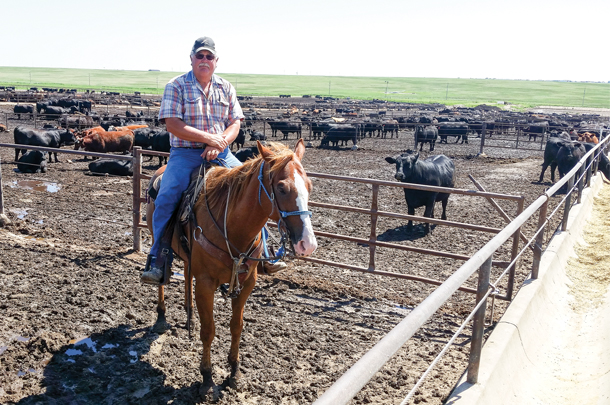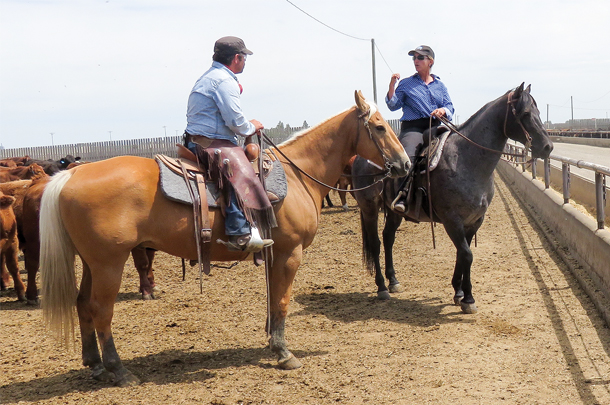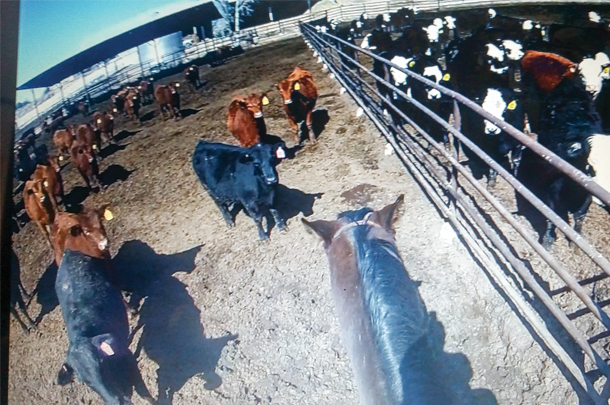Matt Luebbe, feedlot extension and research specialist, University of Nebraska – Lincoln, puts on feedlot schools to train personnel for feedlots in Nebraska. “I host a feedlot roundtable series for owners and managers, and also see a need to target employees. Some of them may not have a high school education and might not speak English. If some of them speak Spanish, I have a translator for them,” he says.
These schools are for feed truck drivers, feed mill operators and cowboys working with cattle. “The first year, I did a survey and listed issues ranging from horse management to beef quality assurance certification, antibiotic treatments and withdrawal periods, and had feedlot participants rank these in order of concern.
We tackled some of the highest-ranking issues, and during the last five years, we’ve been able to cover most of the topics on that list,” says Luebbe.
“In these schools, we always have a segment targeting feedlot cowboys. When possible, we use a hands-on approach. We get some animals in a chute and a veterinarian explains the steps for diagnostics.
There will be some things a person will observe before the animal gets to the chute, such as lameness. But the veterinarian starts with general diagnostics, looking at heart rate, body temperature, listening to the lungs, looking at eyes, checking to see if the animal is dehydrated, etc.,” he says.
The program is targeted toward employees, but sometimes the feedlot sends the owner or manager because they can’t send the crew for a day. “Sometimes we’re training the trainer so they can disseminate information. This can have a multiplier effect, and we are accomplishing what we set out to do,” says Luebbe.

Arlan Tobyne, a feedlot consultant in Kansas, is trying to promote a college course for future feedlot employees. “We need a school to teach people who come into this field, just like we teach electricians, carpenters, mechanics or any other technical work.”
In the course Tobyne sets up, she was going to include working with cattle and teach about injections and injection sites, handling vaccines and inventory. “Then we would help the graduates find jobs. Feedlots would have confidence in the ability of a student from this program,” he says.
The industry needs better and more training for feedlot employees and pen riders. If new employees have to learn “on the job,” it can be hard on the cattle and it doesn’t work very well. “Some employees quit after a short time, and you have to start over. It would be better to provide training for pen riders before they start that first job.”
De-stressing cattle

Lynn Locatelli, DVM (Cattlexpressions in New Mexico), works with a variety of feedlots in the Midwest and Canada. “One problem is that pen rider training is almost always focused on health issues, whereas there are many other steps necessary to achieve an accurate health check."
'Most programs focus on how individual animals should be assessed. My approach is different. I integrate Bud Williams’ low-stress handling principles with veterinary medicine,” she says.
“Pen checkers are stewards of wellness – encouraging cattle to eat, drink, play and interact normally with penmates. We get to know the pen and individual cattle.” A person becomes familiar with what’s normal for each pen and for the individuals as well.
“Those unique characteristics can be recognized and worked with. Panic can be calmed. Confused cattle can be taught to respond to and work for handlers. Content cattle that play and settle quickly in the feedlot soon learn to work for handlers. When pen riders work at a level where they can observe behavioral details about a pen and not just scan for sick cattle, they make accurate observations,” she says.
“Working at this level soon develops trust between cattle and handlers, which is necessary to identify early pulls,” she explains. When cattle are at ease with a pen checker, they don’t become nervous or agitated when they see that person; they are relaxed and doing their normal activities and express how they truly feel.
“An effective pen checker gets an honest read on cattle. When pen riders rapidly move through pens, simply prowling for sick cattle, the cattle may be fearful and alert – and can effectively hide sickness. This results in late pulls and compromised treatment response,” says Locatelli.

Low-stress handling facilitates many aspects of cattle care and saves on labor. “If cattle trust the handlers, one person can easily move a single animal out of a pen without disrupting the others or stressing that animal. Feedlots shouldn’t need two people to chase an animal out of a pen,” she says.
Locatelli trains pen checkers, processors, shippers and transport professionals. “Often the people who haven’t done this before are good students. They don’t have a pre-formed idea of how things should be done.”
Pen riders who have already been cowboys have an idea about how they should handle cattle, and it may not be as low-stress as they think.
“Most important is the effect good pen checkers can have on a daily basis to de-stress the animals. All kinds of cattle come into a feedyard – from gentle, low-stressed animals to extremely high-stressed, high-health- risk animals. Good pen checkers can create trust in all cattle and healthy, more uniform behavior patterns."
"Pen checkers are vital in de-stressing cattle and in creating behaviors in cattle that make them easier to work – for processors and shippers and other feedlot staff. The role of pen checkers is often misunderstood, and their importance is traditionally underemphasized,” she says. ![]()
PHOTO 1: Cattle are calm when they trust the pen rider and may not even bother to get up until you ask them to.
PHOTO 2: Arlan Tobyne developed a course for teaching feedlot cowboys.
PHOTO 3: Dr. Lynn Locatelli (on right horse) giving a teaching session for pen riders.
PHOTO 4: View from the Go-Pro camera – Cattle put their eyes on the pen rider and wait for what he or she wants them to do. Photos provided by Arlan Tobyne.

-
Heather Smith Thomas
- Freelance Writer
- Salmon, Idaho
- Email Heather Smith Thomas
Tips on teaching trust
Arlan Tobyne trains feedlot employees. He grew up on a farm where his father had a small feedlot. “This is where I learned about handling feedlot cattle 40 years ago. A good vet taught me how to look at cattle in a pen – to be very quiet and not scare them. I learned how to move them and take a sick one out without disturbing the others,” he says.
“More recently, I worked with Dr. Tom Noffsinger for seven years. He explained a lot of things, and then I understood what I was doing and why it worked. Before that, I didn’t know how to tell people about point of balance, flight zone, using pressure and release, etc., to make cattle move the way you want them to.”
About five years ago, Tobyne tried to turn this knowledge into a program to teach students how to handle cattle in a feedlot. “I started making videos so people could see what I was seeing, using a Go-Pro camera you attach to yourself,” he says.
The videos show that if you want to put pressure on one animal but even look at the wrong one, you move that calf – just because he caught you looking at him. Your eye contact invaded his comfort level/security space.
“If I did it right, however, I could move the one I wanted, even if he was standing behind another calf. I could move the targeted animal if I caught his eye and didn’t look at the other one.” If you totally ignore the one you don’t want, he feels safer and doesn’t bother to move. Cattle are tuned in to your intentions. Being a prey animal, they are aware of anything that might be stalking them and become highly alert.
“It’s all about trust and the communication process. The way you look at them, and even the way your horse acts, makes a big difference. An aggressive horse makes cattle nervous. If you go into a pen of cattle that are used to one caregiver and they are not used to you, they look at you differently. It takes a little time before they trust you.”
If cattle are mishandled, it takes more time to settle them down. “There are some exercises you can do with them where they learn control in a low-stress manner and learn what you are asking them to do.
You can walk with them to slow them down or walk against them to speed them up, and there are simple ways to change their direction and ask them to stop. In three or four days of quiet handling, you can have them doing anything you want them to, with no stress, and they will be much gentler,” he explains.
“When I go into a pen of cattle, I don’t want them to move until I ask them to. I do want them to get up to assess them. I want them to take a couple of steps to make sure they are feeling all right and not lame.
You want them to put their eyes on you. When they turn and put their eyes on you, they are asking what you want them to do. This is part of communication. When you get them to that point, it’s really easy to pick out any sick ones.”







